
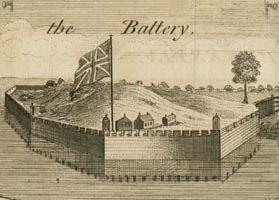
"The East Prospect of the City of Philadelphia" [detail], engraving after George Heap, in the London Magazine, October 1761.
Section 5: Plain Truth
Nearly all of Franklin’s printing and writing was undertaken for profit, but in the two months before his retirement in 1748, he devoted his press to a political cause: pressuring the Quaker-dominated Assembly to establish a militia for defense against marauding attacks by the French. Franklin employed all the skills he had learned as a writer and printer to promote self-defense, including broadsides, blank forms, lottery tickets, and pamphlets. He thus initiated a media campaign that brought together speech (meetings and sermons), printing, and manuscript (the signing of forms, petitions, and lottery tickets, as well as the writing of speeches and pamphlets.
The laboured and long-continued Endeavours [to make] Provisions for the Security of the Province having proved abortive, I determined to try what might be done by a voluntary Association of the People. To promote this I first wrote and published a Pamphlet, entitled, PLAIN TRUTH, in which I stated our defenseless Situation in strong Lights, with the Necessity of Union and Discipline for our Defense, and promis’d to propose in a few Days an Association to be generally signed for that purpose. The Pamphlet had a sudden and surprising Effect. I was call’d upon for the Instrument of Association. And having settled the Draft of it with a few Friends, I appointed a Meeting of the Citizens in the large Building before-mentioned.
The House was pretty full. I had prepared a Number of printed Copies, and provided Pens and Ink dispers’d all over the Room. I harangu’d them a little on the Subject, read the Paper and explain’d it, and then distributed the Copies which were eagerly signed, not the least Objection being made.Benjamin Franklin, Autobiography
![A Tradesman of Philadelphia, Plain truth: or, serious considerations on the present state of the city of Philadelphia, and province of Pennsylvania ([Philadelphia]: Printed [by Benjamin Franklin] in the year MDCCXLVII [1747]). Charles Norris’s copy.](images/thumbs/th5.1.jpg) A Tradesman of Philadelphia, Plain truth: or, serious considerations on the present state of the city of Philadelphia, and province of Pennsylvania ([Philadelphia]: Printed [by Benjamin Franklin] in the year MDCCXLVII [1747]). Charles Norris’s copy.
A Tradesman of Philadelphia, Plain truth: or, serious considerations on the present state of the city of Philadelphia, and province of Pennsylvania ([Philadelphia]: Printed [by Benjamin Franklin] in the year MDCCXLVII [1747]). Charles Norris’s copy.
Plain Truth was published by “A Tradesman of Philadelphia,” but Charles Norris has added “Benjamin Franklin” on the title page of his copy. Norris also wrote “Dr. Franklin” at the end of the pamphlet.
![A Tradesman of Philadelphia, Plain Truth [Second impression] ([Philadelphia]: Printed [by Benjamin Franklin] in the year MDCCXLVII [1747]).](images/thumbs/th5.2.jpg) A Tradesman of Philadelphia, Plain Truth ([Philadelphia]: Printed [by Benjamin Franklin] in the year MDCCXLVII [1747]).
A Tradesman of Philadelphia, Plain Truth ([Philadelphia]: Printed [by Benjamin Franklin] in the year MDCCXLVII [1747]).
This woodcut of a farmer praying to Hercules for help in getting his cart out of the mud was previously used by Franklin in a popular school book with the caption, “He that won’t help himself, shall have Help from no Body.” The image would have been familiar to most people.
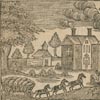 Die lautere Wahrheit, oder Ernstliche Betrachtung des gegenwärtigen Zustandes der Stadt Philadelphia (Philadelphia: Gedruckt, und zu finden bey Gotthard Armbrüster, 1747).
Die lautere Wahrheit, oder Ernstliche Betrachtung des gegenwärtigen Zustandes der Stadt Philadelphia (Philadelphia: Gedruckt, und zu finden bey Gotthard Armbrüster, 1747).
In the German translation of Plain Truth, the woodcut of Hercules and the farmer, which Franklin loaned to Ambrüster, is used on the title page, replacing the Latin quotation from Sallust in the English edition.
![A Tradesman of Philadelphia, Plain Truth ([Philadelphia]: Printed [by Benjamin Franklin] in the year MDCCXLVII [1747]).](images/thumbs/th5.4.jpg) A Tradesman of Philadelphia, Plain Truth ([Philadelphia]: Printed [by Benjamin Franklin] in the year MDCCXLVII [1747]).
A Tradesman of Philadelphia, Plain Truth ([Philadelphia]: Printed [by Benjamin Franklin] in the year MDCCXLVII [1747]).
he first impression contained an erratum at the bottom of the first page: “those those who seem to sleep,” which has been corrected in manuscript in this copy. The error was corrected in the second impression.
Gilbert Tennent, The late Association for Defence, encourag’d, or The Lawfulness of a Defensive War (Philadelphia: Printed by William Bradford, [1748]).
In this sermon, Tennent specifically praised Plain Truth as “an excellent Performance.”
![[William Currie], A Sermon, Preached in Radnor Church, on Thursday, the 7th of January, 1747 [i.e., 1748]. (Philadelphia: Printed and Sold by Benjamin Franklin and David Hall, 1748).](images/thumbs/th5.6.jpg) [William Currie], A Sermon, Preached in Radnor Church, on Thursday, the 7th of January, 1747 [i.e., 1748]. (Philadelphia: Printed and Sold by Benjamin Franklin and David Hall, 1748).
[William Currie], A Sermon, Preached in Radnor Church, on Thursday, the 7th of January, 1747 [i.e., 1748]. (Philadelphia: Printed and Sold by Benjamin Franklin and David Hall, 1748).
This fast day sermon, published by Franklin and Hall, reveals the importance of oral communication, as well as printing, in the campaign for self-defense.
![[John Smith], The Doctrine of Christianity, as Held by the People called Quakers, Vindicated (Philadelphia: Printed by Benjamin Franklin and David Hall, 1748).](images/thumbs/th5.7.jpg) [John Smith], The Doctrine of Christianity, as Held by the People called Quakers, Vindicated (Philadelphia: Printed by Benjamin Franklin and David Hall, 1748).
[John Smith], The Doctrine of Christianity, as Held by the People called Quakers, Vindicated (Philadelphia: Printed by Benjamin Franklin and David Hall, 1748).
Smith’s defense of Quaker pacifism was printed by Franklin and Hall, despite the fact that it opposed the Association for Defense to which Franklin was passionately committed.
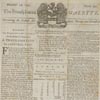 The Pennsylvania Gazette (Philadelphia: B. Franklin, December 12, 1747).
The Pennsylvania Gazette (Philadelphia: B. Franklin, December 12, 1747).
This issue printed the “Proclamation for a General Fast” that Franklin wrote for the Assembly. It also publicized the “Scheme of the Philadelphia Lottery” to raise money for the defense of Philadelphia.
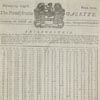 The Pennsylvania Gazette (Philadelphia: B. Franklin and D. Hall, February 23, 1748.)
The Pennsylvania Gazette (Philadelphia: B. Franklin and D. Hall, February 23, 1748.)
The drawing of the first lottery took place on February 7–8, 1748. On February 23, three of the four pages of the paper were given over to listing the prize-winners.
![[Matthew Green], A Copy of Verses Wrote by a Gentleman, lately deceased, Occasion’d by his Reading Robert Barclay’s Apology (London, Printed; Philadelphia, reprinted by B. Franklin, [1747?]).](images/thumbs/th5.10.jpg) [Matthew Green], A Copy of Verses Wrote by a Gentleman, lately deceased, Occasion’d by his Reading Robert Barclay’s Apology (London, Printed; Philadelphia, reprinted by B. Franklin, [1747?]).
[Matthew Green], A Copy of Verses Wrote by a Gentleman, lately deceased, Occasion’d by his Reading Robert Barclay’s Apology (London, Printed; Philadelphia, reprinted by B. Franklin, [1747?]).
This broadside was probably published by Franklin as part of his attempt to gain support from “moderate” Quakers for a defensive militia.
![Form of Association for Defense [Philadelphia: Benjamin Franklin, 1747]. Historical Society of Pennsylvania.](images/thumbs/th5.11.jpg) Form of Association for Defense [Philadelphia: Benjamin Franklin, 1747]. Historical Society of Pennsylvania.
Form of Association for Defense [Philadelphia: Benjamin Franklin, 1747]. Historical Society of Pennsylvania.
This is the only surviving copy of the printed forms in support of the Association for Defense that Franklin circulated on November 24, 1747. Space was left blank on the verso, on which supporters could sign.
![Lottery ticket, Third Class (Philadelphia: B. Franklin and D. Hall, 1748]. Historical Society of Pennsylvania.](images/thumbs/th5.12.jpg) Lottery ticket, Third Class (Philadelphia: B. Franklin and D. Hall, 1748]. Historical Society of Pennsylvania.
Lottery ticket, Third Class (Philadelphia: B. Franklin and D. Hall, 1748]. Historical Society of Pennsylvania.
This lottery ticket is one of the 30,000 tickets that Franklin printed for the second lottery in support of the Association of Defense. Many such small tickets could be printed on a single sheet of paper, which was then cut up.
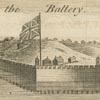 George Heap, The Battery, detail of The East Prospect of the City of Philadelphia, in the London Magazine (London, October, 1761).
George Heap, The Battery, detail of The East Prospect of the City of Philadelphia, in the London Magazine (London, October, 1761).
The money Franklin’s Association for Defense raised funded a militia company and the construction of this fort, called the Battery, on the Pennsylvania side of the Delaware River just south of the city.
![Gilbert Tennent, The late Association for Defence, encourag’d, or The Lawfulness of a Defensive War (Philadelphia: Printed by William Bradford, [1748]).](images/thumbs/th5.5a.jpg)
![Gilbert Tennent, The late Association for Defence, encourag’d, or The Lawfulness of a Defensive War (Philadelphia: Printed by William Bradford, [1748]).](images/thumbs/th5.5b.jpg)